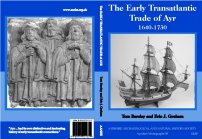 |
 |
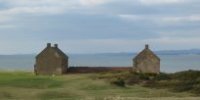 |
 |
AANHS
|
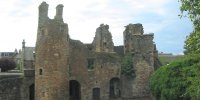 |
Copyright notice: Links to this site are welcomed. However none of the material on the site may be duplicated in any form. The copyright of the articles is the property of the authors. Copyright of the web pages is the property of David McClure. |
These monographs are published by the Ayrshire Archæological & Natural History Society. Copies may be obtained, subject to stock, from Denis Rattenbury, 4 Ewenfield Avenue, AYR KA7 2QG (price as shown below post free in UK only). |
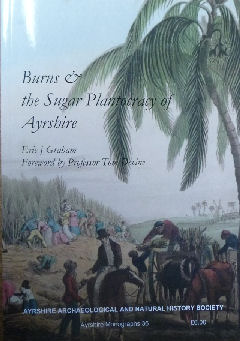 |
Eric J. Graham, Burns & the Sugar Plantocracy of Ayrshire, (No. 36, 2009, £6.00), 124 pages. ISBN 978 0 9542253 8 4
Foreword by Professor Tom Devine. |
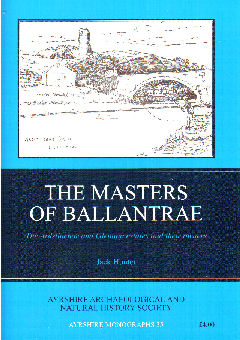 |
Jack Hunter, The Masters of Ballantrae: The Ardstinchar and Glenapp estates and their owners, (No. 35, 2009, £4.00), 30 pages. ISBN 978 0 9542253 9 1 |
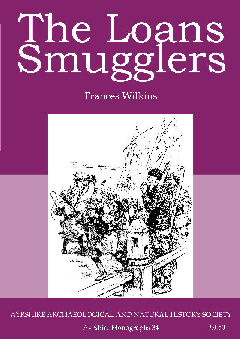 |
Frances Wilkins, The Loans Smugglers, (No. 34, 2008, £4.50), 144 pages. ISBN 978 0 9542253 7 7
'There are no less than twelve dissolute and dangerous persons, whose constant business has been to support their iniquitous trade of running goods ashore upon the coast of this Kingdom by force and have acted to the terror of the officers of the revenue and their assistants and it is highly to be suspected that some of them are outlawed in Ireland ... they are liable to be imprisoned and tried for the forcibly obstructing and hindering and resisting the officers in the due execution of their duty.'
The story of smuggling in 18th century Ayrshire, drawn from original sources in archives in Ayr, Edinburgh Glasgow, the Isle of Man, and London.
25 sketches, maps, and tables. |
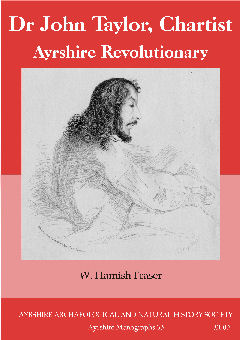 |
W. Hamish Fraser, Dr John Taylor, Chartist: Ayrshire Revolutionary, (No. 33, 2006, £4.00), 112 pages. ISBN 0 9542253 5 X
'Every inch a man and a gentleman', John Taylor became a leading light of the Chartist movement, with a reputation for violent demagoguery that we hear in other circumstances today. He was born in Newark Castle and, despite his revolutionary ideals and brushes with the law, was remembered with affection in Ayr, where he is commemorated by a statue in Wallacetown cemetery.
Hamish Fraser has provided a fascinating and detailed account of his career and of a time when the security of the state itself seemed to be in jeopardy.
11 illustrations. |
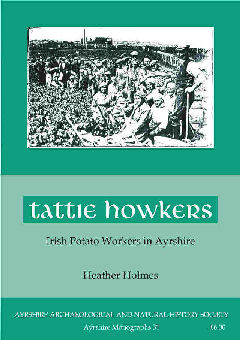 |
Heather Holmes, Tattie Howkers: Irish Potato Workers in Ayrshire, (No. 31, 2005, £4.50), 192 pages. ISBN 0 9542253 4 1
Until the 1970s seasonal workers from Ireland were a common sight in the Ayrshire potato fields, particularly in the coastal parishes. The cover photograph shows a large squad at Balig, in Ballantrae. By custom, having completed the harvest there this group moved to Langlands, in Tarbolton. According to one source, 'Every visitor to Girvan and other resorts in Ayrshire has seen the potato diggers at work in the fields, driving to the post office on Saturday night to send their hard won earnings home to old folks in Achill.'
Heather Holmes gives a full account of the tattie howkers, the farms on which they were employed and their working and living conditions, and of the institutions that engaged in their regulation and welfare.
2 maps and 12 illustrations. |
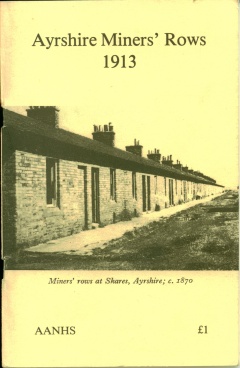 |
Although it has been out of print for some time, Ayrshire Miner's Rows, 1913, published in a facsimile edition by the AANHS in 1979, is still in demand.
It has now been published in a digital edition on the Ayrshire History Website.
To go to it, just click on the title above. |
|
|
Tom Barclay and Eric J. Graham, The Early Transatlantic Trade of Ayr 1640-1730, (No. 30, 2005, £4.50), 104 pages, ISBN 0 9542253 3 3. This account describes in detail the families, vessels, cargoes, and destinations involved in Ayr's early transatlantic trade, set against a background of upheaval: the Civil War, the Restoration of Charles II, the Wars of the Three Kingdoms that ended the reign of James VII (or II), and the Union of the Parliaments of England and Scotland in 1707.
This publication was reviewed by David Ransome in The Local Historian, vol. 36.1, February 2006, 56. |
|
|
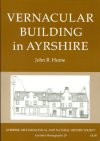 |
John R. Hume, Vernacular Building in Ayrshire, (No.29, 2004, £4.50), 80 pages, ISBN 0 9542253 2 5. A revised and much extended edition of the monograph first published in 1988 (Monograph 3), this contains 102 line drawings, Captain John Slezer's view of Ayr, and a map showing places mentioned in the text. Also contains a glossary of architectural terms and a bibliography.
Read a review by David B. Smith
|
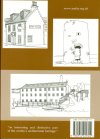 |
|
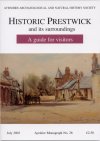 |
Historic Prestwick and its surroundings: A Guide for Visitors, (No. 28, 2003, £2.50), 64 pages. ISBN 0 9542253 1 7. An illustrated walking tour of Prestwick and cycle or car tour of Monkton, Tarbolton, Barnweil, St. Quivox, and Auchencruive, with clear annotated sketch maps, an index, and a bibliography. |
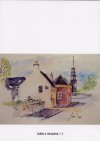 |
|
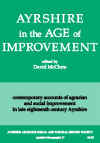 |
Now available as a pdf (excluding cover). Download here. (1858 KB) David [Courtney] McClure, Ayrshire in the Age of Improvement (No.27, 2002, £6.00), 192 pages. ISBN 0 9542253 0 9. CONTENTS: Introduction; Sketch Map of Ayrshire Parishes; Present State of Husbandry in Ayrshire by Andrew Wight (1778); Colonel William Fullarton of Fullarton: A biographical note by Rob Close; General View of the Agriculture of the County of Ayr by Col. Fullarton; Appendix 1: Publications of Col. William Fullarton; Appendix 2: Weights, measures and money; Appendix 3: Lime, limekilns and the economics of limestone burning; Appendix 4: Cost of enclosing and improving land. With copious endnotes and an index. Read the INTRODUCTION here. Read a REVIEW of this book. |
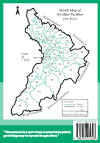 |
|
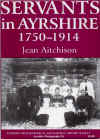 |
Jean Aitchison, Servants in Ayrshire 1750-1914 (No.26, 2001, £5.00), 144 pages. ISBN 0 9527445 5 4. The author draws on kirk session records, estate papers, parliamentary reports, memoirs, oral history recordings and many published works to present a picture of the circumstances of the servant class in the county, from the middle of the eighteenth century to the eve of the First World War. With full citation of sources, five appendices and an index, this is both a narrative which brings the subject to life, and a valuable reference work on the county and the period. 11 illustrations. Review by Rob Urquhart.
Now out of print. Servants in Ayrshire is now available to download as a pdf file (excluding only the cover). This is a large file and should only be downloaded using a broadband connection.
Download Servants in Ayrshire (approx. 3.5MB). |
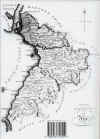 |
|
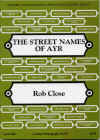 |
Rob Close, The Street Names of Ayr (No.25, April 2001, £5.00), 136 pages. ISBN 0 9527445 9 7. A fascinating and authoritative account of the derivation of the street names of Ayr, past and present, by the author of Ayrshire and Arran: An Illustrated Architectural Guide, (Edinburgh, 1992). |
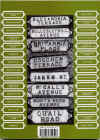 |
|
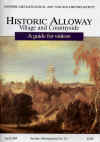 |
Historic Alloway: Village and Countryside.
A Guide for Visitors (No. 24, April 2000, £2.00). i
map; 60 pages. |
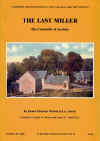 |
James Pearson Wilson, The
Last Miller: The Cornmills of Ayrshire (No. 23, February
2000, £6.00). 8 illustrations. 80 pages. |
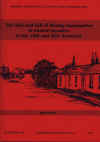 |
Gavin Wark, The Rise and Fall of Mining Communities
in Central Ayrshire in the 19th and 20th Centuries (No. 22,
September 1999, £3.00). 3 maps. 56 pages. |
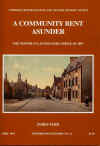 |
James Mair, A Community Rent Asunder:
The Newmilns Laceweavers Strike of 1897 (No. 21, April 1999,
£3.50). 11 illustrations. 52 pages. |
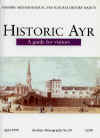 |
Historic Ayr: A guide for visitors (No.
20, April 1998, £2.00). Illustrations and map. |
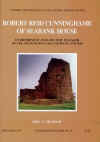 |
Eric J. Graham, Robert Reid Cunninghame of
Seabank House: Entrepreneur and Life-time Manager of the
Stevenson Coal Company 1770-1814 (No. 19, September 1997,
£3.60). 17 illustrations. 48 pages. |
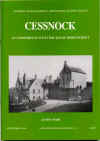 |
James Mair, Cessnock: An Ayrshire Estate
in the Age of Improvement (No. 18, September 1996, £4.50).
64 pages.
|
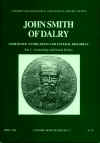 |
John Smith of Dalry: Geologist, Antiquarian and Natural Historian; Part 2 - Archæology and Natural History (No. 17, April 1996, £7.20). 80 pages. |
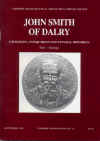 |
John Smith of Dalry: Geologist, Antiquarian
and Natural Historian; Part 1 - Geology (No. 16, September
1995, £6.00). 56 pages. |
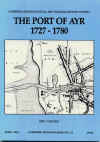 |
Eric J. Graham, The Port of Ayr 1727-1780 (No. 15, April 1995, £4.20). 48 pages. The revival of Ayr as an international port during the 18th century, the ships involved in the trade and the commodities imported and exported are revealed in this study based on extensive examination of the letter and day books of the Customs Collectors at Ayr and Irvine.
|
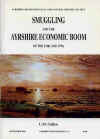 |
L. M. Cullen, Smuggling and the
Ayrshire Economic Boom of the 1760s and 1770s (No. 14, September
1994, £4.00). 56 pages. |
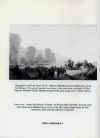 |
|
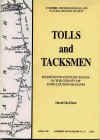 |
David McClure, Tolls and Tacksmen: Eighteenth
Century Roads in the County of John Loudon McAdam (No. 13,
April 1994, £3.60). 1 map. 56 pages. |
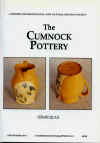 |
Gerard Quail, The Cumnock Pottery
(No. 12, September 1993, £5.00). Illustrations, many
in full colour. 76 pages. |
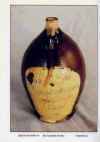 |
|
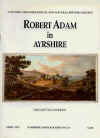 |
Margaret H. B. Sanderson, Robert Adam in Ayrshire
(No. 11, April 1993, £3.60). 12 illustrations.
36 pages. |
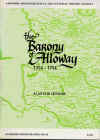 |
Alastair Hendry, The Barony of Alloway 1324-1754
(No. 10, [1992]). 40 pages. |
back to top |
|
| Home About Articles Bibliography Links Research Postings Search | |
